Decreased USP2a Expression Inhibits Trophoblast Invasion and Associates With Recurrent Miscarriage
- PMID: 34489969
- PMCID: PMC8416978
- DOI: 10.3389/fimmu.2021.717370
Decreased USP2a Expression Inhibits Trophoblast Invasion and Associates With Recurrent Miscarriage
Abstract
An appropriate development of the placenta consisting of trophoblast cell migration, invasion, proliferation, and apoptosis, is essential to establishing and maintaining a successful pregnancy. Ubiquitin-specific protease 2a (USP2a) regulates the processes of metastasis in multiple tumor cells. Yet, no known research has focused on exploring the effect of USP2a on trophoblasts and its possible mechanism in the pathogenies of recurrent miscarriage (RM). In this study, we first detected the decreased mRNA levels and the protein levels of USP2a in placental villous tissue samples from the RM patients. In vitro assays verified that overexpression of USP2a promoted human trophoblast proliferation, migration, invasion, whereas knockdown of USP2a inhibited these processes. Mechanistically, USP2a activated PI3K/Akt/GSK3β signaling pathway to promote nuclear translocation of β-catenin and further activated epithelial-mesenchymal transition (EMT) in the trophoblasts. Moreover, transforming growth factor-beta (TGF-β) up-regulated USP2a expression in trophoblasts. Interestingly, M2 macrophage secreted TGF-β induced trophoblast migration and invasion, and an anti-TGF-β antibody alleviated this effect. Collectively, this study indicated that USP2a regulated trophoblast invasion and that abnormal USP2a expression might lead to aberrant trophoblast invasion, thus contributing to RM.
Keywords: TGF-β; USP2a; decidual macrophage; recurrent miscarriage; trophoblast invasion.
Copyright © 2021 Wang, Ding, Zhang, Chen, Yan, Zhang and Yin.
Conflict of interest statement
The authors declare that the research was conducted in the absence of any commercial or financial relationships that could be construed as a potential conflict of interest.
Figures
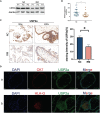
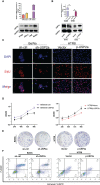
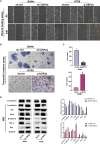

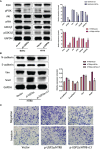
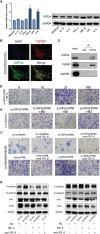

Similar articles
-
The miR-27a-3p/USP25 axis participates in the pathogenesis of recurrent miscarriage by inhibiting trophoblast migration and invasion.J Cell Physiol. 2019 Nov;234(11):19951-19963. doi: 10.1002/jcp.28593. Epub 2019 Apr 5. J Cell Physiol. 2019. PMID: 30953360
-
Decreased stathmin-1 expression inhibits trophoblast proliferation and invasion and is associated with recurrent miscarriage.Am J Pathol. 2015 Oct;185(10):2709-21. doi: 10.1016/j.ajpath.2015.06.010. Epub 2015 Aug 10. Am J Pathol. 2015. PMID: 26272359
-
Ubiquitin-specific protease 7 prevents recurrent spontaneous abortion by targeting enhancer of zeste homolog 2 to regulate trophoblast proliferation, apoptosis, migration, and invasion through the Wnt/β-catenin pathway†.Biol Reprod. 2023 Aug 10;109(2):204-214. doi: 10.1093/biolre/ioad053. Biol Reprod. 2023. PMID: 37249558
-
Traditional and New Routes of Trophoblast Invasion and Their Implications for Pregnancy Diseases.Int J Mol Sci. 2019 Dec 31;21(1):289. doi: 10.3390/ijms21010289. Int J Mol Sci. 2019. PMID: 31906245 Free PMC article. Review.
-
The Role of TGF-β during Pregnancy and Pregnancy Complications.Int J Mol Sci. 2023 Nov 28;24(23):16882. doi: 10.3390/ijms242316882. Int J Mol Sci. 2023. PMID: 38069201 Free PMC article. Review.
Cited by
-
Crosstalk between Placental Trophoblast and Decidual Immune Cells in Recurrent Miscarriage.Int J Med Sci. 2023 Jul 31;20(9):1174-1188. doi: 10.7150/ijms.86533. eCollection 2023. Int J Med Sci. 2023. PMID: 37575278 Free PMC article.
-
Ubiquitin-proteasome system: a potential participant and therapeutic target in antiphospholipid syndrome.Front Immunol. 2025 Feb 18;16:1523799. doi: 10.3389/fimmu.2025.1523799. eCollection 2025. Front Immunol. 2025. PMID: 40040717 Free PMC article. Review.
-
Role of protein post-translational modifications in unexplained recurrent pregnancy loss.Zhong Nan Da Xue Xue Bao Yi Xue Ban. 2024 Sept 28;49(9):1495-1502. doi: 10.11817/j.issn.1672-7347.2024.240365. Zhong Nan Da Xue Xue Bao Yi Xue Ban. 2024. PMID: 39931779 Free PMC article. Review. Chinese, English.
-
Decidual stromal cells-derived exosomes incured insufficient migration and invasion of trophoblast because of abnormal ubiquitination and degradation of Snail mediated by miR-92b-3p/USP28.BMC Biol. 2025 Jul 22;23(1):222. doi: 10.1186/s12915-025-02326-4. BMC Biol. 2025. PMID: 40696416 Free PMC article.
-
MANF Promotes Unexplained Recurrent Miscarriages by Interacting with NPM1 and Downregulating Trophoblast Cell Migration and Invasion.Int J Biol Sci. 2024 Jan 1;20(1):296-311. doi: 10.7150/ijbs.85378. eCollection 2024. Int J Biol Sci. 2024. PMID: 38164189 Free PMC article.
References
Publication types
MeSH terms
Substances
LinkOut - more resources
Full Text Sources
Research Materials

